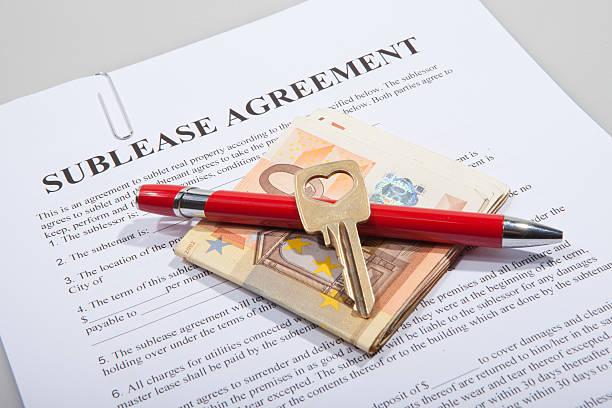Before exploring what is a sublease agreement, one critical step often overlooked is running a background check on a potential subtenant. Think of it as your first layer of protection. While subleasing can feel like a practical fix when life circumstances change, it’s still a financial and legal commitment. By checking a subtenant’s rental history, credit score, or references, you reduce the risk of dealing with missed payments, property damage, or even disputes with your landlord.
Imagine this scenario: you move abroad for six months and decide to sublease your apartment. Without a background check, you might hand the keys to someone unreliable. Later, your landlord could hold you responsible for unpaid rent or violations, even though you weren’t physically present. A little diligence at the beginning can save a lot of stress later.
Understanding the Basics of a Sublease Agreement
At its core, a sublease rental agreement is a contract that allows a tenant to rent out all or part of their leased property to another person. The tenant who holds the original lease is known as the sublessor, and the new occupant is the subtenant. Importantly, the lease with the landlord remains in the original tenant’s name.
There are two primary types of subleases:
- Residential sublease agreement – Common when tenants rent out part or all of their apartments, condos, or houses. For example, a college student might sublease their apartment during summer break.
- Commercial sublease agreement – Typically used when businesses have excess office or retail space. Instead of letting that space go unused, they rent it out to another business.
Unlike a new lease, a sublease doesn’t break the existing contract, it simply extends temporary use rights to someone else. This makes subleases a valuable option for those seeking flexibility without completely walking away from their rental.

Key Elements Every Sublease Agreement Should Include
When drafting a sublease, clarity is everything. A vague agreement can quickly lead to disputes. Here are the most critical elements every residential or commercial sublease agreement should spell out clearly:
- Parties involved: Names of the landlord, the sublessor (you), and the subtenant.
- Lease duration: The start and end dates of the sublease period.
- Rent details: How much the subtenant will pay, to whom, and on what date.
- Utilities and services: Clear outline of who is responsible for electricity, water, gas, and internet.
- House rules or business restrictions: Pets, noise levels, smoking policies, or modifications to the space.
- Security deposit terms: Whether you’ll collect one, how much it will be, and when it is refundable.
- Landlord consent: Some jurisdictions require landlords to sign off on every sublease.
Without these details, you risk confusion. For example, if utilities aren’t specified, you could end up paying for someone else’s excessive heating bill.
Why Tenants Choose to Sublease Their Rental
Subleasing is more than just a fallback option, it often provides practical solutions for real-life challenges. People choose to sublease for reasons such as:
- Temporary relocation: A tenant may need to move for work, military service, or family obligations but plans to return.
- Travel opportunities: Long-term travel or studying abroad often makes subleasing a cost-effective way to keep a home without paying rent for unused space.
- Financial relief: Subleasing a room or portion of a property helps tenants reduce monthly expenses.
- Business flexibility: For companies, a commercial sublease agreement lets them share office costs, especially during periods of downsizing.
➡️ When comparing subletting vs subleasing, note the subtle distinction: “subletting” usually implies renting out part of a unit (like one room in an apartment), while “subleasing” can mean either the whole property or just part of it. Both approaches have benefits, depending on your needs.

Pros and Cons of a Sublease Agreement
Advantages of Subleasing
- Helps tenants avoid breaking their lease.
- Keeps the property occupied during travel or relocation.
- Provides a steady stream of rent from the subtenant.
- Useful for businesses managing unused square footage.
Drawbacks to Keep in Mind
- The original tenant remains financially responsible to the landlord.
- A poor choice of subtenant can create financial and legal issues.
- Some landlords strictly prohibit subleasing.
- There’s an added layer of paperwork and negotiation.
Like any financial decision, it’s about weighing the trade-offs. For some, the peace of mind knowing rent is covered outweighs the risks.
Legal and Practical Considerations for Tenants
Subleasing may sound straightforward, but laws and lease agreements often add complexity. Some factors to consider include:
- Landlord’s approval: In many states, you can’t legally sublease without written consent. Skipping this step may lead to eviction.
- Jurisdiction-specific rules: Cities like New York and San Francisco have detailed regulations about subleasing that tenants must follow.
- Liability concerns: If the subtenant damages the property or fails to pay, you remain liable.
- Insurance coverage: Renter’s insurance might not extend to your subtenant, so clarify this with your provider.
Taking the time to review your lease and local laws ensures your sublease agreement doesn’t accidentally put you in breach of contract.

Tips to Create a Secure and Clear Sublease Agreement
To protect yourself and create a smooth rental relationship, consider these tips:
- Use a reliable template: Start with a residential sublease agreement or commercial sublease agreement form tailored to your state.
- Screen subtenants carefully: Beyond credit checks, ask for references from prior landlords.
- Set expectations in writing: Document rules for cleaning, guests, and shared spaces.
- Collect a deposit: This provides security if the subtenant leaves damage.
- Maintain communication: Keep both the subtenant and landlord in the loop about important matters.
A well-drafted agreement not only protects your rights but also makes the subtenant feel secure about their responsibilities.
Final Thoughts on Sublease Agreements
A sublease can be a lifeline for tenants and businesses alike. It offers flexibility, financial relief, and peace of mind when handled properly. But without careful planning and legal awareness, it can also create challenges. Always check your lease terms, seek landlord approval, and put everything in writing.
If you’re thinking beyond subleasing and want to explore real estate more seriously, there are resources to guide you. Dwanderful, led by real estate investor and podcast host Dwan, provides powerful insights for anyone curious about property opportunities. She even offers a free book, Real Estate Lingo, which simplifies the jargon every renter or investor should know. For those ready to dig deeper, her paid guide, Five Pillars of Real Estate Investing, outlines the core strategies for long-term success.
And here’s something fun: Dwanderful also has a quiz that reveals how you could generate six figures in the next six months. Whether you’re buying your first property or your next, it takes less than a minute and can open your eyes to new possibilities in real estate. Contact us now!

Frequently Asked Questions
Do I need my landlord’s permission before creating a sublease agreement?
Most of the time, yes. Leases often require explicit written approval from the landlord. Failing to obtain consent could put you at risk of eviction.
How is a sublease different from letting someone take over my lease?
A sublease means you’re still legally tied to the lease. With an assignment (someone taking over your lease), the new tenant becomes fully responsible, and you’re usually released from obligations.
Can a sublease agreement protect me if my subtenant stops paying rent?
The agreement gives you a legal framework to pursue the subtenant, but your landlord will still expect payment from you. A detailed contract reduces risks but doesn’t remove them entirely.
What should I include in a sublease agreement to avoid disputes?
Be specific: rent amount, due dates, utilities, property rules, security deposit terms, and landlord consent. The clearer the agreement, the smoother the arrangement.



